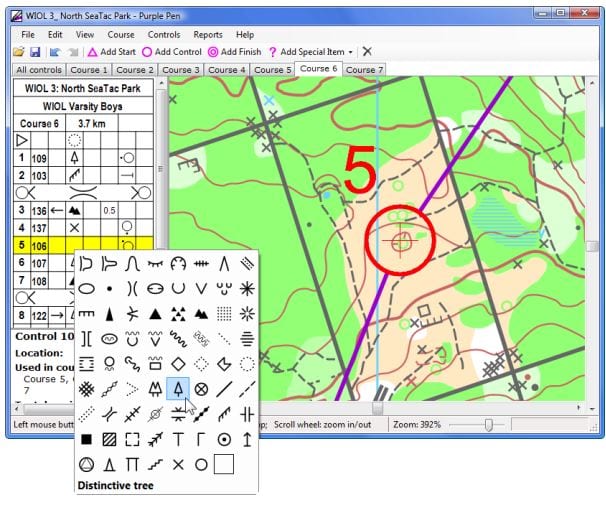How to be a Planner
A Quantock Orienteers one page guide
There are three officials involved in any orienteering event: Planner, Controller and Organiser. The Planner designs the courses, which the Controller checks.
This article summarises the planning process.

Credit: Purple Pen website
Design courses
Successful planning is a time consuming exercise, so start early!
Check which courses are needed. At a JOG there are usually four courses: Hare, Squirrel, Badger and Fox. At a QO Forest League event there are usually eight courses: White, Yellow, Orange, Light Green, Short Green, Green, Blue and Brown. Other events can have different combinations.
Before starting, get the latest British Orienteering rules and guidance. All can be found here: although the relevant parts are Appendix B and Appendix E. For a successful event the primary requirement is to conform to the safety rules in Appendix E, with the appropriate technical difficulty and length for each course as defined by Appendix B.
Course lengths are defined in Appendix B - use the long distance event table. Generally QO's areas are quite technical and physically demanding, so the course lengths should be at the short end of the range. A good way to judge the right course length is to look at the results from the last event in that area, noting the course length. The time taken by most competitors on longer courses should be around an hour.
Get the latest copy of the map. It may also be worth getting copies of the courses from the last event in the area, this will give ideas, and avoid unintentionally repeating the last planner's courses. Also check with the permissions secretary what parts of the area can be used and whether the landowners have set any conditions on the land use.
Designing courses can be done in many ways. Most planners will start with an "armchair" planning exercise. Most planners will use course setting software such as Purple Pen which can be used with any map in .jpg or .pdf format.
If the area includes roads then a key consideration must be avoiding road crossings where possible. See section 4.9 in Appendix E. The rules may result in some courses being restricted to those over 16. If you need marshalls at road crossings, then agree this with the organiser.
It is often best to start by designing the white and yellow courses. This will probably decide the start, finish and car park locations. Get these agreed with the controller at an early stage. Try to keep these as close together as possible and still comply with the course guidelines.
The number of controls needed for a QOFL would normally range from 30 to 45 depending on the area.
Site visits
Having prepared draft courses go out into the forest to visit all the control sites. If the site is suitable then "tag" the site with a matchbox size piece of coloured insulating tape. You may find tags in places from previous events - remove these and it may be wise to write some unique code on your tape e.g. your initials.
You will probably need at least three visits to the wood to tag sites, as your courses evolve and adapt to any changes you find when you are out there. Keep an eye out for any features where the map may not be correct or up to date. Either get the map updated, or avoid these areas.
When all sites are tagged, send your plans to the Controller. Expect the Controller to require changes. Don't be defensive! Remember the Controller is trying to help troubleshoot the event.
When the courses are agreed with the Controller send them to the mapper for map preparation and printing.
Set out controls
Arrange to collect the controls in advance of the day. You can place around six controls per hour, so to have the courses ready on time you may need to set some out the day before. However, to avoid theft and vandalism, only set out the more obscure controls - leave those in public areas and on paths to be set out on the event day.
Before the day prepare a plan for putting out the controls and divide them accordingly. When placing controls take a list of control descriptions. Tapes have a habit of disappearing. Also have one available for the controller/checker.
Collect controls
Get about five people to help on the day by collecting controls. Wait until the Organiser says that everyone is finished, or until courses close before collecting.
Have an all controls map and cut it into sections, one for each person. This should ensure that all controls are collected. Purple Pen provides a report which shows which courses each control is on, which aids early control collection when some courses have finished but not others.
Ask collectors to remove the tag as well as bringing back the controls.
After the event
As soon as possible afterwards, the results team need a copy of your Purple Pen file and base map to set up Routegadget, though you could email it to them before the event once courses are finalised.
- Originally written by Richard Sansbury but since added to by others